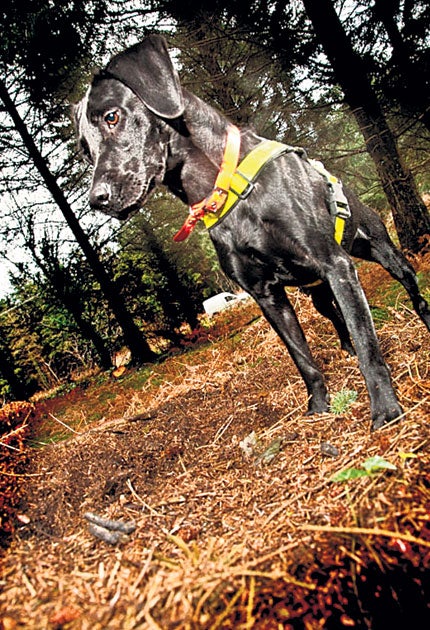Conservation Dogs: eco researchers
Dogs' sniffing powers have helped to detect bombs and smell signs of cancer. Now they're being used to track down endangered wildlife. Sue Corfield reports

The sight of a snarling mutt might not be the first thing which an endangered newt thinks of when it comes to a bright future. But conservationists are turning to man's best friend to lend a helping paw to find endangered animal species.
Documenting the location and number of rare animals isn't easy. Conservation Dogs is the UK's first organisation to train and use pooches to find endangered species, or rather their signs – such as droppings, carcasses or nests – to aid researchers in their goals of eco research, management and conservation.
The dogs' incredible sense of smell and ability to discern individual scents, even when they are masked by other odours, are reasons why Louise Wilson, director of Conservation Dogs, started to diversify into conservation.
Louise said: "Some estimates suggest that [the dogs'] sense of smell is at least 100,000 times more sensitive than ours. As a result, scat detection dogs have been able to demonstrate greater success at locating scats than human search teams using visual detection. Research suggests that dogs are at least 96 per cent effective.
"Each animal's scat contains DNA specific to it," she said. "By collecting scat samples, we can help get a population count for a location. This allows conservationists to formulate an estimate for a larger area."
Louise and her black Labrador, Luna, are currently tracking elusive pine martens in the wilds of Scotland.
"Conservationists need to find out what is reducing the populations," she said. "Is it disease? Predators? Loss of habitat? We need to know the reproduction rates. We can then address issues that cause these animals to become endangered."
Depending on the environment and its stamina, the dog can work six to eight hours with regular breaks. Working in a zig-zag pattern, it can detect scats within at least 15 metres and can identify a target odour from over a 100 metres away. The dog shows a natural "indication" or "alert" once a scat is found. When it comes to training, Labradors and springer spaniels are usually the dogs of choice and, on average, the training takes around six to 12 weeks. Louise uses samples of scat collected from zoos and other wildlife organisations for identification purposes.
She said: "It can be difficult to secure sample droppings to use for training purposes. Zoos and conservation organisations are often the only sources. The dogs are exposed to those samples and rewarded for finding them. We also expose them to scat from other animals, such as foxes or weasels, but we don't reward them for finding those droppings. This teaches the dogs to ignore those."
Scat training is also successful for a growing number of commercial organisations. For example, one pest control company has turned to dogs to sniff out entry and exit points for mice infestation cases.
Wind farm sites, keen to establish the extent of bat mortalities through turbine impact, use dogs to sniff out carcasses. Here, dogs provide an accurate and more detailed insight into the resulting mortality rate.
Great crested newts and natterjack toads are just a few more endangered species destined to benefit from the assistance of canines. Hotels and hospitals could soon be able to enlist the support of these conservation dogs in sniffing out problems such as bed bugs.
There's so much potential that, soon, canines might be regarded as not just man's but Mother Nature's best friend, too.
Subscribe to Independent Premium to bookmark this article
Want to bookmark your favourite articles and stories to read or reference later? Start your Independent Premium subscription today.

Join our commenting forum
Join thought-provoking conversations, follow other Independent readers and see their replies